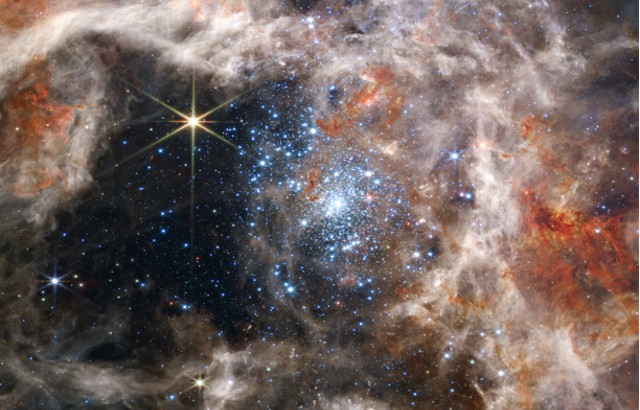AU academic awarded €2m from European Research Council to investigate planet forming discs
Dr Thomas Haworth from QMUL's Astronomy Unit has been awarded a European Research Council (ERC) Consolidator Grant worth €2m to investigate how planet forming discs evolve in different environments.

A massive cluster of stars in the Tarantula Nebula. Credit: NASA.
We now expect that pretty much every star in our Galaxy hosts at least one planet. We also have overwhelming evidence that those planets are born in flattened discs of material around young stars. In some cases we can even see the young planets embedded within those discs.
Our best view of discs comes from those that are relatively close to the Sun. These nearby discs are brighter, and it’s also easy to resolve features in them than more distant discs. However nearby discs turn out to be in quite calm, gentle environments. Most stars form in very large groups, where massive stars emit vast amounts of ultraviolet (UV) radiation. For example, one single star that is 40x more massive than the sun emits something like 300 billion times more UV light than the sun (factor 50 sunblock won’t cut it!). The UV light strips material from planet forming discs, shrinking them and leaving them with less time, material and locations to form planets. This leads to a “nature versus nurture” question, of whether the planets that stars eventually end up with depends on the wider environment that the planet formation was happening in.
We know that the harsh UV light certainly can affect discs, because in the harsh UV environment of the Orion Nebular Cluster we can actually see material streaming off them. They stop looking disc-like and take on a cometary appearance that we call a "proplyd".
This ERC grant will fund groundbreaking research and a large team to work with Dr Haworth to understand how discs evolve in different environments. They will develop new state of the art simulations to study how material is removed from the discs, how that interacts with other processes in the disc, and how everything ties together to affect the way discs evolve and form planets. Dr Haworth’s team will also address the question of when in their lifetime the discs actually get exposed to the harsh environment, using simulations of the birth of clusters of stars.
In addition to simulations, Dr Haworth’s team will use observations with state-of-the-art telescope facilities like the James Webb Space Telescope to test their models.
Dr Haworth said: “There is a question of if you started with the same young star and planet-forming disc, would you get different planets depending on what environment you put that disc in? This ERC project will lead to major advances in our understanding of how discs evolve, and hence how planets form in different environments.”
Professor Wen Wang, Queen Mary's Vice-Principal and Executive Dean for Science and Engineering, said: “I'm pleased to see that yet another outstanding Queen Mary astrophysicist has won ERC funding to investigate how planets are formed – this research will truly enhance our understanding of the universe. Congratulations to Dr Haworth and everyone else who’s work made this possible.”